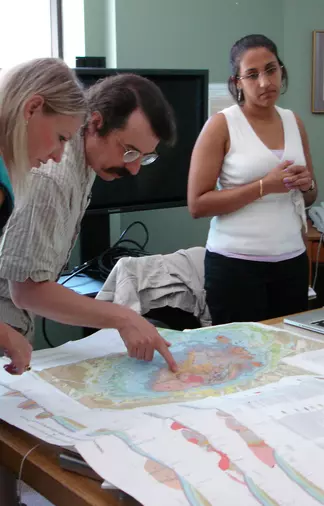Geoscience Habits of Mind

Temporal reasoning
The concept of deep time is one of the distinguishing characteristics of the geosciences. We expect geoscientists to have an intuitive sense for the scale of geologic time, the rates of geologic processes, and the uncertainties associated with ages and rates, while also having a general understanding of Earth's history. For geoscience students, learning these skills and content is no easy undertaking, and it requires repeated practice. But an appreciation for geologic time is important for all citizens, not just geoscientists. The perspective provided through the long history of the planet is critical to developing ways to live sustainably on Earth in the future. Helping all students develop their temporal reasoning skills and understanding of deep time is an important component of facilitating geoscience literacy.
Read more about how to integrate temporal reasoning into your teaching.
Spatial thinking
Geoscientists easily combine evidence from a wide range scales—extracting information about the uplift of mountain ranges from the textures seen in a thin section for example. Many times, students are required to understand spatial visual information contained within abstract visualizations. For some people, understanding spatial representations can be a barrier to becoming a successful geoscientist. This barrier can be overcome through good instruction and practice.
Read more about how to integrate spatial thinking into your teaching.
Geographic facility
Geoscientists are constantly putting information into a geographic context, asking where a rock was collected or where an earthquake occurred. The ability to quickly assess whether or not something is "normal" or relies heavily on that geographic context. For students, working from a place-based perspective can help them learn to put information in a geographic context.
Read more about how to integrate geographic facility into your teaching.
Systems thinking
The Earth is a complex system with multiple interacting components and feedbacks. Concepts like the rock cycle, first introduced by James Hutton in the 1700's, characterize the nature of this complex system. Geoscientists typically identify feedbacks and interactions within these systems, build models to study complex system behaviors, and identify and describe emergent behaviors which would not have been predicted from the underlying driving mechanisms (Manduca and Kastens, 2012) .
Read more about systems thinking and how to teach it.
They truly are "habits", and thus can be easily overlooked by those who are using them. Being aware of your own habits of mind can help you develop them in your students.
Additional resources
- The Synthesis of Research on Thinking and Learning in the Geosciences project brought together geoscience, education, cognitive science, and learning research experts to summarize "existing knowledge and articulate unanswered questions" about geoscientific thinking. The panel focused on geologic time, complex earth systems, spatial thinking, and field-based learning.
- Thinking about thinking is known as metacognition, and helping your students become more aware of how they learn and process information is a first step towards helping them become expert thinkers in any field.